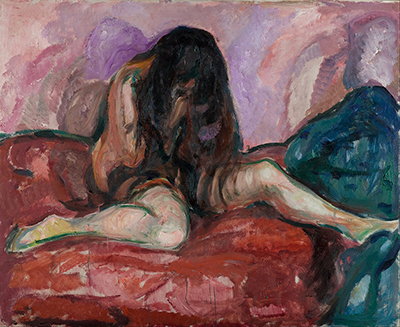The Weeping Nude was created from 1913-1914 by Edvard Munch in Norway. Munch was a printmaker and painter recognized for his Expressionism style in his representation of emotions. He is associated with several palettes, themes and styles of drawing.
Although he executed his early paintings in an Impressionist style, later he got inspirations from Han Jaeger and changed his artwork. As a result, Munch began to focus on inner psychological states and abandoned his previous subjects drawn from surface appearance representation. Also, Munch got his influence from Impressionists such as Edouard Manet and Claude Monet followed by the post-impressionism artists Paul Gauguin, Paul Cezanne and Vincent van Gogh. Besides, all his styles influenced several upcoming artists, especially the leading proponents of German Expressionism.
One year before World War I, Munch portrayed an identified nude woman weeping - "Weeping Nude." "Weeping Nude" is an example of the superb works where Munch attracted a stream of female models whom he painted in most of his nude portraits. In this painting, the model holds her hands to her face. Her long dark hair covers the face and the viewer cannot doubt that she is weeping uncontrollably. She is totally abandoned in her miserly. The painting portrays a feeling of unease, anxiety and suffering. The circumstances driving to her weeping are not known and she appears to be relatively isolated. Isolation is one theme that Munch knew well, a common theme in his life. The diverse and unnatural color palette strikingly contrasts with the rich thick and black lines in this painting. The scene is emotional and reproduced with expressive strokes and vibrant colors.
Like many of his generation, Munch got his influence from Japanese tradition which he applied in his use of woodcuts. However, he simplified the process by using single blocks of wood sawed in smaller pieces. Munch used the grain of the wood to experiment and express his purposes which greatly influenced later artists. Also, he frequently overlaid or combined different mediums on top of one another. All of his paintings closely resemble his prints in both the subject matter and style. Within the same period, Munch's other related artwork includes nudes such as the Morning Yawn, 1913 and other selected works such as Workers on Their Way Home, 1913-14. The Morning Yawn shows a nude woman sitting on the edge of her bed and yawning while Workers on Their Way Home shows a tramp of weary workers on the road on their way home. The portrait shows a distant vanishing point that goes up to and beyond the picture plane. The Weeping Nude portrait is displayed in the Munch Museum of Art, Oslo.




